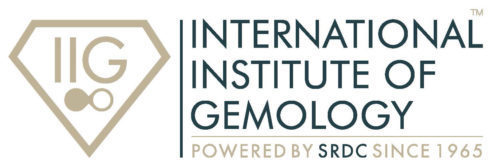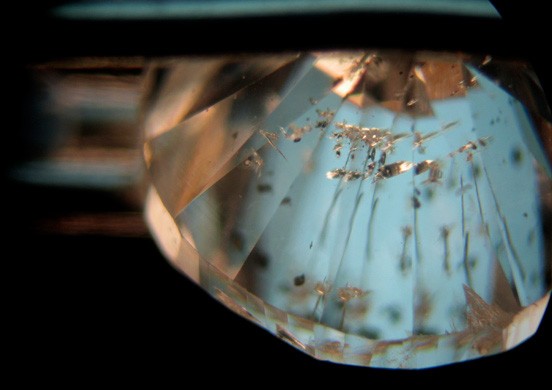What are Diamond Treatments?
Diamond treatments are specific enhancements, performed on natural diamonds (usually those already cut and polished into gems), which are designed to improve the visual gemological characteristics of the diamond. It is also known as “TREATMENTS” Diamonds can be subjected to a variety of treatments, which are used in the attempt to improve either the color or clarity of the stone.
Treated diamond
A diamond having undergone any human intervention other than cutting, polishing, cleaning, and setting, to permanently or non-permanently change its appearance, for example coating, fracture filling, heating, irradiation, laser drilling, HPHT treatment.
These include Clarity Treatments such as laser drilling to remove black carbon inclusions, fracture filling to make small internal cracks less visible, Color Treatments irradiation and annealing treatments to make yellow and brown diamonds a vibrant fancy color such as vivid yellow, blue, or pink.
Clarity Treatments (Enhancement)
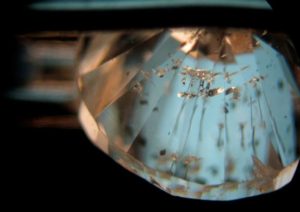 Laser drilling
Laser drilling
Laser drilling is a treatment used to reduce the visibility of dark natural inclusions that reduce a diamond’s clarity grade. It involves drilling with a laser beam a minute tunnel through the diamond, in order to remove a dark spot buried inside the stone. To the untrained eye, the laser tunnels appear to be natural inclusions, and they too may be fracture-filled to further improve clarity
Typically, a laser beam with a diameter of fewer than 0.02 millimeters is used. The concentration of light on an extremely small area of the diamond causes its temperature to rise to a point at which it evaporates, forming the tunnel thatch stretches from the surface to the inclusion. The inclusion itself is then vaporized with the laser, and the entire area is often bleached to conceal any residual dark material. Laser drilling is easily be detected under a loupe with 10X magnification. If it is fracture-filled, the filler material in the drill tunnels will show color flashes.
A more recent variation of the normal laser treatment focuses a laser beam onto an internal inclusion near the diamond’s surface producing a fracture that travels from the inclusion to the surface creating the opening for the bleaching agents. In this treatment method (called KM laser treatment) there is no tell-tale drill tube.
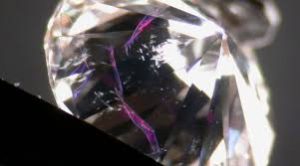 Fracture Filling
Fracture Filling
The fracture filling of the diamond is often the last step in the process of diamond enhancement, following laser drilling and acid-etching of inclusions, though if the fractures are surface-reaching, no drilling may be required. This process, which involves the use of specially-formulated solutions with a refractive index approximating that of the diamond, was pioneered by Zvi Yehuda of Ramat Gan, Israel. Yehuda is now used as a brand name applied to diamonds treated in this manner.
Normally it is believed to use lead-bismuth oxychloride glass, but research into creating better, more durable, less traceable solutions are still being done, creating more silicone-based solutions for the fracture filling process.
Fracture filling is not a stable treatment and MUST be disclosed at the point of sale. The glass filling is susceptible to heat and can perspire out of a fracture or sometimes change color if the diamond is heated when jewellery is repaired. For this reason, stones that have been fracture-filled cannot be issued a color or clarity grade because the appearance of the stone changes dramatically when the diamond is first treated and the changes in the diamond are not permanent.
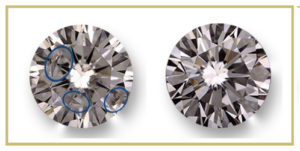
Color Treatments (Enhancement)
 Irradiation and Annealing
Irradiation and Annealing
Irradiation of diamonds involves the use of high energy particles to change the crystal lattice of a diamond. The alteration in the crystal lattice results in a change of color in the diamond. The colors produced by irradiation vary due to the color of the starting material and the method of irradiation used.
After irradiation, diamonds can also be heated under special conditions (called Annealing) to further change their color to a number of attractive fancy colors. UV-Vis-NIR spectrometry is useful in identifying if a diamond has been irradiated to produce its fancy color.
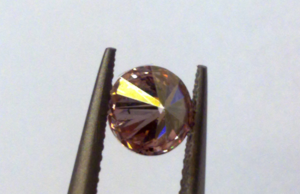 Coating
Coating
Coating is a way of enhancing a diamond’s color and is the oldest diamond treatment known, dating back to the Georgian period. The original method of surface coating entailed applying colored tinfoil to the back surfaces of gemstones and diamonds that were mounted in closed-back settings. Surface coating involves the deposition of colored material in a thin layer over the surface of the stone. The coating, therefore, results in a change in the color of the stone. The surface coating must be disclosed at the point of sale. The coating is not a stable treatment, as over time the coating wears away or is scratched off. Surface coating is identified using the microscope, which can be used to observe worn or scratched areas, or areas where the coating has flaked off. Coated stones are very sensitive to heat and abrasive agents such as some cleaning solutions and plating solutions used to give jewellery the finishing touches.
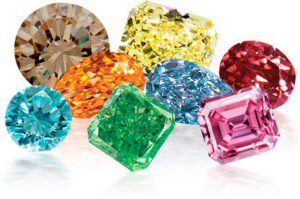 High-Pressure High-Temperature (HPHT)
High-Pressure High-Temperature (HPHT)
HPHT involves the application of extremely high pressures and temperatures to a rough or polished diamond, resulting in a change of color. HPHT treatment can transform brown type II diamonds to near colorless or colorless, and rarely can result in pink or blue diamonds from type II stones. Type I brownish colored stones can be transformed to fancy yellow or fancy greenish-yellow. HPHT treatment of type II diamonds can be identified using Raman, while UV-Vis and other spectrometric analyses are used to identify HPHT treated type I stones.
Important Points of Diamond Treatments:-
- Diamond treatment usually involves improving the total quality of the diamond by modifying the inclusions and/or enhancing or changing the color.
- Some treatments are stable and permanent while others may not be that stable and can suffer damage during setting, wear, cleaning, and repair.
- Some treatments can be easily identified by expert eyes and some are very complicated one has to take the support of advanced technology and types of equipment to check and identify the treatments.
- Treatment doesn’t turn Natural Diamonds into Synthetics, After treatment also the diamond (body material) remains Natural diamond only.
- International Laboratory issue certificate with the comment that diamond is being treated with particular treatments. The value automatically gets reduced in comparison with similar color-clarity diamond not undergone any human intervention.
- Treated Diamonds and Synthetic Diamonds both are not the same, Treated means Natural Diamonds which are undergone any human intervention whereas, Synthetic Diamonds means Lab Grown or Man-made Diamonds, Made in a laboratory using cutting-edge technology that replicates the natural diamond growing process.
- A diamond loose or studded in jewellery has been artificially colored or any clarity enhancement treatments are performed it is mandatory that fact about the treatment must be disclosed.
Buying Guide about TREATED DIAMONDS:-
One should buy treated diamonds or No? this is a very personal question, depend upon individual preference. But buying a treated diamonds at the natural diamond prices will be considered a big mistake and at the same time as a fraudulent transaction by the seller or retailer. Treated diamonds are optically upgraded, but their quality will remain significantly lower. So, there is also high risk and the durability issue for that particular diamonds which are heavily treated or filed with lead-bismuth oxychloride glass.
That’s why you can buy these diamonds at a cost which is an average of 30 to 50% lower than non-treated diamonds with the same clarity or color. Do you think this is a good opportunity to buy larger diamonds with a smaller budget? Go for it !! but the important fact here is “Disclosure” which is very much essential for treated diamonds to buy and sell as TREATED DIAMONDS.

